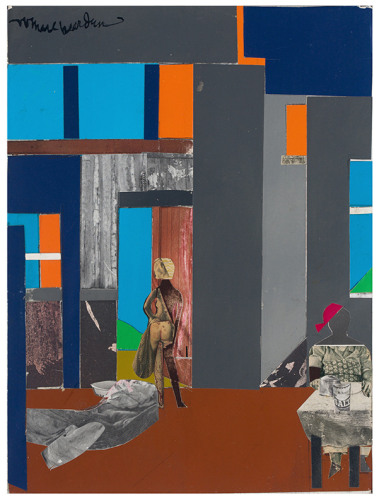
Blue Monday, 1969
Collage of various papers on fiberboard, mounted to plywood
12 x 9 in.


Opening Reception
Thursday, March 23, 6-8pm
Special Dance Performance of Bayou Fever Breakdown by Dada Masilo
Showtimes: Friday, March 24, 6pm & Saturday, March 25, 6pm
Please RSVP to rjohnson@dcmooregallery.com. More information
DC Moore Gallery’s new exhibition, Romare Bearden: Bayou Fever and Related Works, features a series of twenty-one vibrant collages from 1979 that Bearden conceived for a ballet that invokes African American traditions and the African presence that is deeply rooted in the Louisiana bayou near New Orleans, and elsewhere in North America and the Caribbean. Never before shown in New York, the collages represent the main characters and settings of a performance that he hoped would be choreographed by Alvin Ailey.
Bearden (1911-1988) had worked with Ailey before, most notably two years earlier when he created a scrim for the ballet, Ancestral Voices. He had been interested in dance for some time, as his wife had her own company, the Nanette Bearden Contemporary Dance Theater. While the Bayou Fever dance was never performed, the bold imagery of Bearden’s collages speaks to the power of his visual imagination and narrative strength of his original concept.
An illustrated catalog with an essay by Robert O’Meally will be available.
Ritual, magic, and mystery infuse the Bayou Fever series. Much of the storyline centers on a confrontation between the Conjur Woman and the Swamp Witch, in a dramatic struggle between good and evil that plays out in a rural cabin deep in the bayou. Overall, the dance’s imagery incorporates many of the most prominent motifs and elements found in Bearden’s art, including strong women, elders, musicians, Caribbean masquerade figures, domestic interiors, and rural landscapes, in addition to the powerful Conjur Woman. His costume designs for the characters in the dance often combine photos of African masks with pieces of cloth and textiles.
The collages are based on memory for the most part, as was often the case in Bearden’s art. Some refer to his childhood in Mecklenburg County, North Carolina, such as The Mother Hears the Train, The Magic Root (Spotted Deer and the Father), The Herb Woman, The Blue Demons, and The Swamp Witch, Blue-Green Lights and Conjur Woman. Others concern his experience in Paris in the early 1950s, especially Star from the Heavens, which alludes to the moment many years earlier when he stood looking at Notre Dame Cathedral in the early morning hours and imagined seeing an angel walking across the Seine.
The additional artworks in the exhibition have been selected to complement the imagery and themes of the Bayou Fever series, and highlight their importance in Bearden’s larger body of work. A key element is traditional African American and African Caribbean belief and religion. In the early 1980s, Bearden explored ritual aspects of Obeah, a religious practice in the Caribbean, which originated in Ghana and is similar to Haitian Vodou. Bearden created Obeah images in a series of bold watercolors, while, Hoodoo, its counterpart in the United States, is reflected in the enigmatic figures of the Conjur Woman and other powerful, mysterious women.
Other religious imagery is significant as well, especially expressions of Christian faith. Images of, baptism, burial and other ceremonies provide references to rituals Bearden saw as fundamental to the African American experience.
Closely related to these more sacred rites are processions and parades, where the religious and the secular often overlap, particularly in places like New Orleans and the surrounding area. Bearden frequently turned his attention to local ceremonies and celebrations, festivals, and carnival figures, a colorful group of which will figure prominently in the show.
Throughout his life, Bearden often acknowledged women’s place at the heart of the African American community. As mothers, sisters, and midwives, as well as healers and herbalists, they were and still are the caretakers of the family and neighborhood, holding important leadership roles throughout the American South, as evidenced in his images of strong, independent women seen throughout the exhibition.
Bearden was also very interested in the communities themselves, both in people united by shared history and culture, and the landscapes that they inhabited. Several of the collages and watercolors will feature views of the rural South and Caribbean countryside.
DC Moore Gallery is the exclusive representative of the Romare Bearden Estate and Romare Bearden Foundation.